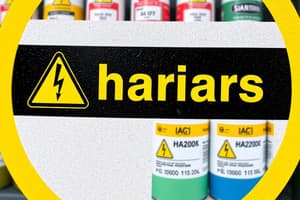Podcast
Questions and Answers
Which type of chemical hazard includes substances like carbon monoxide and cyanide?
Which type of chemical hazard includes substances like carbon monoxide and cyanide?
- Asphyxiants (correct)
- Corrosives
- Flammable
- Irritants
What is the primary characteristic of corrosive substances like sulfuric acid and sodium hydroxide?
What is the primary characteristic of corrosive substances like sulfuric acid and sodium hydroxide?
- They cause skin irritation
- They catch fire easily
- They cause suffocation
- They cause tissue damage upon contact (correct)
Which substance is considered an extreme fire hazard, especially in laboratory settings?
Which substance is considered an extreme fire hazard, especially in laboratory settings?
- Propane
- Cadmium
- Acetone (correct)
- Benzene
Which concept involves recognizing hazards, assessing risks, minimizing risks, and preparing for emergencies from uncontrolled hazards?
Which concept involves recognizing hazards, assessing risks, minimizing risks, and preparing for emergencies from uncontrolled hazards?
What is the primary concern with incompatible compounds in a laboratory setting?
What is the primary concern with incompatible compounds in a laboratory setting?
What has led to many explosions in laboratories according to the provided text?
What has led to many explosions in laboratories according to the provided text?
What is the purpose of Chemical Safety Levels (CSLs)?
What is the purpose of Chemical Safety Levels (CSLs)?
What is the appropriate action for a small liquid spill or splash affecting only a small area of skin?
What is the appropriate action for a small liquid spill or splash affecting only a small area of skin?
What is the recommended attire for working in a laboratory?
What is the recommended attire for working in a laboratory?
What should be used to handle broken glass in a laboratory?
What should be used to handle broken glass in a laboratory?
What should be done before using a chemical in the laboratory?
What should be done before using a chemical in the laboratory?
What action should be taken if clothing is contaminated with a larger spill of a liquid chemical?
What action should be taken if clothing is contaminated with a larger spill of a liquid chemical?
What should be used for emergency fire response in a laboratory?
What should be used for emergency fire response in a laboratory?
What should be worn to protect the eyes when working in the laboratory?
What should be worn to protect the eyes when working in the laboratory?
"Do not work alone in the lab" is an example of:
"Do not work alone in the lab" is an example of:
"Don't Taste or Sniff Chemicals, they are not food" emphasizes:
"Don't Taste or Sniff Chemicals, they are not food" emphasizes:
Flashcards are hidden until you start studying



